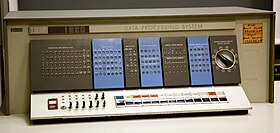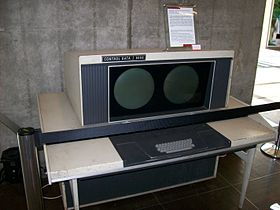This article needs additional citations for verification. (December 2013) |




A front panel was used on early electronic computers to display and allow the alteration of the state of the machine's internal registers and memory. The front panel usually consisted of arrays of indicator lamps, digit[a] and symbol displays, toggle switches, dials, and push buttons mounted on a sheet metal face plate. In early machines, CRTs might also be present (as an oscilloscope, or, for example, to mirror the contents of Williams–Kilburn tube memory). Prior to the development of CRT system consoles, many computers such as the IBM 1620 had console typewriters.
Usually the contents of one or more hardware registers would be represented by a row of lights, allowing the contents to be read directly when the machine was stopped. The switches allowed direct entry of data and address values into registers or memory.
Cite error: There are <ref group=lower-alpha> tags or {{efn}} templates on this page, but the references will not show without a {{reflist|group=lower-alpha}} template or {{notelist}} template (see the help page).